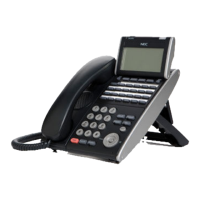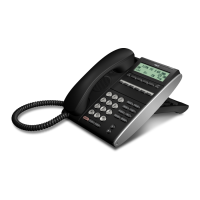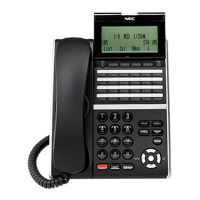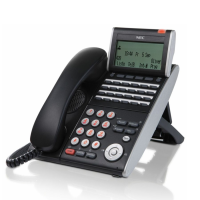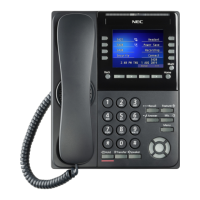
Do you have a question about the NEC DTL-24D-1 - DT330 - 24 Button Display Digital Phone and is the answer not in the manual?
| Speakerphone | Yes |
|---|---|
| Wall Mountable | Yes |
| Type | Digital Phone |
| Buttons | 24 |
| Model Number | DTL-24D-1 |
Displays the physical arrangement of keys and components on the telephone.
Explains the functions of various keys and parts on the ITL-24D-1 model as an example.
Describes how to use the Menu key to access terminal settings and features.
Explains the meaning of icons displayed on the LCD for notifications and status.
Lists and describes the frequently used features accessible via the Shortcut Menu.
Provides examples of features that can be activated by pressing programmable keys.
Details the dynamic functions of soft keys displayed on the LCD based on terminal status.
Notes specific terminal settings that cannot be used on DT700 Series models.
Details how to adjust, remove, and attach the telephone's tilt leg for proper positioning.
Guides on connecting the LAN cable to the telephone and routing it through the provided groove.
Provides instructions for inserting and routing the line cord through the telephone and tilt leg groove.
Explains how to attach the directory card to the telephone set and its holder.
Details the steps for inserting the handset coiled cord into the telephone connector and routing it.
Provides instructions for removing and installing the key set unit, including the line key panel/button panel.
Outlines the steps and space requirements for mounting the telephone set on a wall using the WM-L UNIT.
Explains how to adjust handset receiver volume, speaker volume, and ringer tone using Up/Down keys.
Details how to adjust LCD contrast, microphone on/off, handset receiver volume, and select ringer tone using Feature key.
Describes how to select between Normal, Dynamic Dial Pad, and Preset Dial modes for originating calls.
Guides on how to enable or disable the off-hook ringing feature for the telephone.
Explains how to enable or disable the ringing sound for the headset.
Details the procedure for changing the ringer tone for internal and external calls.
Explains how to set music on hold to be heard by DT Series users.
Describes how to set the clock display format to 12-hour or 24-hour.
Explains how to enable or disable the display of volume levels for handset, speaker, ringer, and LCD contrast.
Details how to set the screen saver, including mode and wait time, for idle telephones.
Guides on how to enable or disable the backlights for the LCD and digit keys.
Explains how to adjust the character size displayed on the LCD screen.
Guides on how to set the display language for the telephone's LCD screen.
Details the procedure for changing the telephone's password used for locking and data management.
Explains how to clear personal data and reset telephone settings to their defaults.
Outlines the steps for downloading files like Music on Hold, Ringer Tone, and Directory using FTP/TFTP.
Guides on backing up personal settings to an FTP/TFTP server, including server setup and IP address entry.
Explains how to restore personal settings from an FTP/TFTP server, including server setup and file transfer.
Provides steps for logging into the DT700 Series telephone system to access features.
Details the procedure for exiting the Web Programming or telephone system session.
Explains how to place a call on exclusive hold and how to retrieve it, preventing others from picking up.
Guides on transferring calls to another station or trunk without attendant assistance.
Explains the steps to make an internal call, including name display for registered contacts.
Details how to answer incoming external calls, showing caller name or number.
Guides on answering internal calls, including name display for registered contacts.
Explains the different modes for entering characters (alphabetic, numeric) and changing case.
Details how to activate and deactivate the security mode, including password entry and screen saver activation.
Explains how to make an emergency call while the telephone is locked in Security mode.
Guides on originating calls using Dynamic Dial Pad and Preset Dial modes for selective dialing.
Explains how to program and use One-Touch Speed Calling keys for quick dialing of numbers or feature access.
Details how to assign names to One-Touch Speed Calling keys for easier identification and dialing.
Describes how to program and use speed dialing for system-wide access codes and abbreviated dialing.
Guides on entering account codes for calls, including procedures after authorization code entry.
Explains the procedure for entering a forced account code for call authorization.
Details how to enter authorization codes for calls, with or without account codes.
Explains how to initiate and respond to voice calls, including usage with soft keys and status indicators.
Guides on answering incoming voice calls hands-free using MIC soft key or speaker key.
Explains how to initiate, answer, and bridge into automatic intercom calls.
Details how to initiate, answer, and bridge into manual intercom calls using MICM and SIG keys.
Explains how to establish three-way conference calls, including using Conf key or soft keys.
Guides on consulting a third party during an active call and alternating between parties.
Explains how to answer a second call while on an existing call, including camp-on indications and call handling.
Details how to program and activate call waiting when originating a call, including using feature keys.
Explains how to program a Call Park key and use it to park and retrieve calls from originating or remote stations.
Guides on picking up calls ringing on other stations within a group, including using the CALL PICK-UP feature.
Explains how to program and use the PICK-DIRECT key to pick up calls ringing on specific stations.
Describes how to queue outgoing calls when the trunk line is busy, including CALL BACK usage.
Explains the procedure for queuing outgoing calls when the telephone is left off-hook and the trunk is busy.
Details how to override a busy station to bridge into a conversation, establishing a three-way conference.
Explains how to redial the last dialed number or scroll through previous numbers using the Redial key.
Guides on setting up call forwarding for all incoming calls to another station or number.
Details how to forward calls to a designated station when the line is busy.
Explains how to forward calls to a designated station if the called station does not answer.
Guides on setting a call destination for IP stations that are logged out.
Explains how to set up a call back when the called station is busy, including using CALL BACK or FLASH key.
Details how to save dialed numbers and repeat them later using the S&R key or soft key.
Explains how to leave a message for another station when it is unanswered or busy.
Guides on displaying, responding to, and erasing messages received on the telephone.
Explains how to set up and originate calls to the Voice Mail System.
Details how Station A can page Station B and transfer a call, including answer codes and connection.
Explains how Station A can page Station B, announce a call, and transfer it, covering scenarios where Station A remains off-hook or hangs up.
Details the steps for a secretary to transfer a call to the boss, including scenarios where the boss accepts or refuses the call.
Explains how to set or cancel the message waiting (MW) indication on the boss' station from the secretary's station.
Describes how to program and use the Boss/Secretary Override key to connect to the boss's line, including different options for handling calls.
Explains how to activate and cancel the Do Not Disturb feature while the phone is idle or off-hook.
Details how to redirect an incoming call to the Call Forward-Don’t Answer destination.
Explains how to activate and cancel the Privacy feature to prevent call interruptions during a conversation.
Describes how to allow another station to enter an ongoing conversation, establishing a three-way conference.
Introduces the two types of phonebooks: System and Local, and their basic usage.
Guides on adding new entries to the Personal Directory, including entering names, numbers, and categories.
Explains how to search for registered data in the directory by group name or by name.
Details how to modify existing entries in the directory, including editing names, numbers, and other details.
Guides on adding a prefix to a telephone number before dialing, allowing for custom dialing sequences.
Explains how to view call history records, including missed, outgoing, and incoming calls.
Details the steps for viewing call history data specifically for DT730 Series telephones.
Guides on initiating calls directly from the call history log, including options for adding prefixes.
Explains how to save call history entries, such as incoming calls, into the personal directory.
Guides on editing directory entries using data obtained from the call history.
Provides instructions for deleting a single, specific call history record from the telephone.
Details the steps for viewing call history data, specifically for incoming and outgoing calls on DT330 Series.
Explains how to view only the missed call history data using the shortcut menu.
Guides on initiating calls directly from the call history log on DT330 Series telephones.
Provides instructions for deleting all call history data of a specific type (incoming/outgoing) on DT330 Series.
Guides on deleting a single, specific call history record on DT330 Series telephones.
Provides a detailed comparison of technical specifications across different DT Series telephone models.
Lists the menu items and their descriptions for navigating the DT730 Series telephone settings.
Lists the menu items and their descriptions for navigating the DT710 Series telephone settings.
Introduces Web Programming for configuring DT Series terminals via PC, detailing system requirements and network considerations.
Guides on accessing the Web Programming interface by starting an internet browser and entering the telephone's IP address.
Details the steps to safely exit the Web Programming interface by clicking the Logout button and closing the browser.
Demonstrates how to operate Web Programming by changing the ringer tone for external calls via the web interface.

